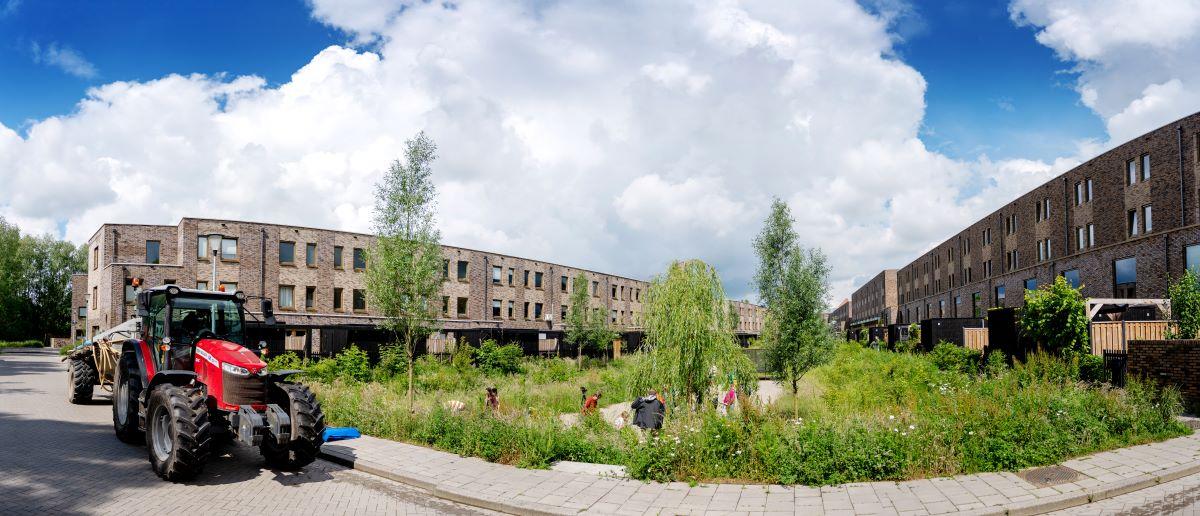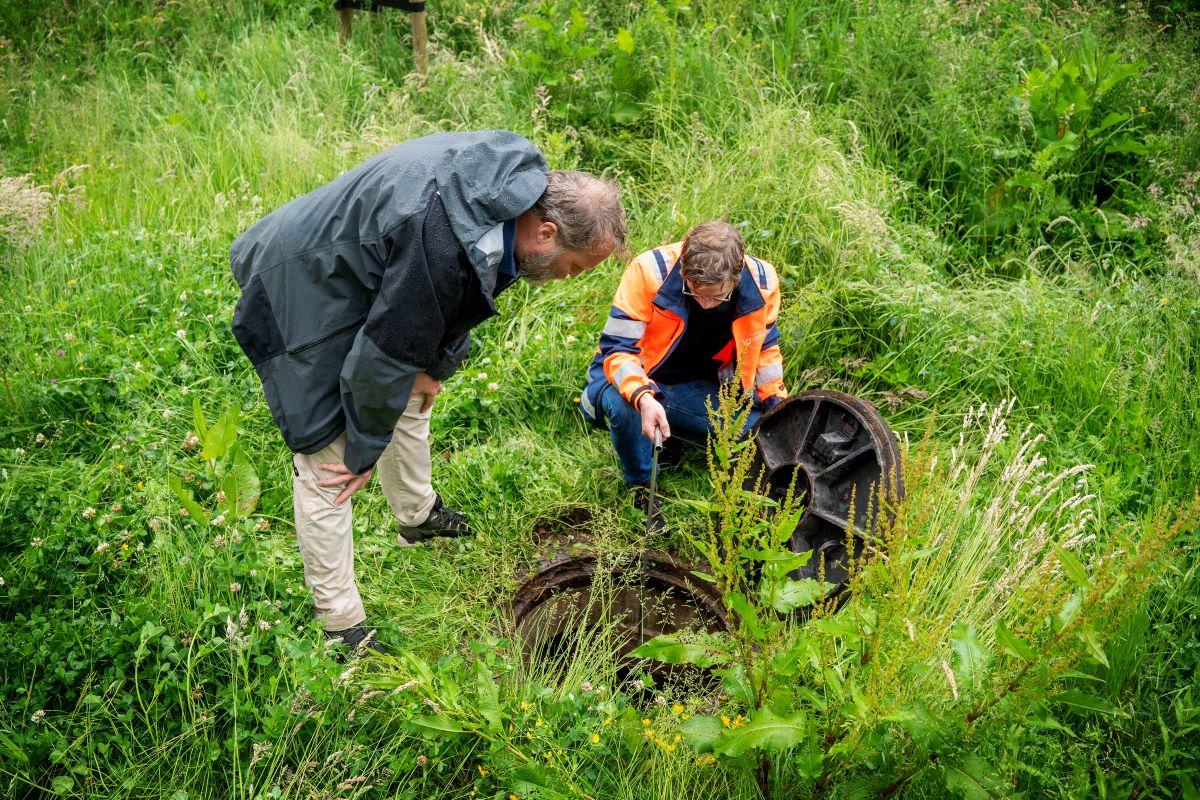Water in the neighbourhood
The extreme rainfall this spring led to damage and disruption in many parts of the Netherlands. Floris Boogaard, an urban water management expert, is calling for a wadi in every street. “Our public spaces can cope with many consequences of climate change by collecting water.” To build confidence in these climate-adaptive measures among concerned residents and to develop knowledge with civil servants, he is going to Groningen today.

The flooding of Curacao Street in Groningen hasn’t been caused by a heavy downpour: the culprit is a tanker from the city authority. It is submerging a parking lot with a permeable surface in one of a series of practical trials for water storage measures. Built Environment students from Groningen’s Hanze University of Applied Sciences are measuring how quickly the ground absorbs water. They are being supervised by lecturer Floris Boogaard, who is also an expert in urban water management at Deltares, and Richard Walters, an urban water consultant working for the City of Groningen.

Seeing for yourself
“Nothing inspires confidence like seeing for yourself how the water disappears into the ground,” smiles Floris. With Richard, he has been organising these practical days for almost a decade. “You get a better feel for it that way,” nods Richard. “It also give my colleagues and me a clearer picture: are we doing the right things in the right places? In the end, that helps us use our capacity and energy efficiently.”
Floris sees this day as a live Climate Café. He organises these meetings to raise awareness and spread knowledge about climate-adaptive solutions. Under his leadership, administrators, civil servants, scientists, professionals and local residents get together every week online to share their experiences and expertise about climate adaptation with water storage, greening and using rainwater. “It gets people enthusiastic about working on a future-resilient city.” Floris posts the Climate Cafés on YouTube and manages climatescan.nl, the world’s largest citizen science database with climate-adaptive solutions.
Extreme weather
May 2024 was the wettest month on record but it won’t be exceptional in the future, predicts Floris, putting up his hood as another shower starts. “Extreme weather is increasing due to climate change, and rainfall is getting heavier.” Downpours this spring led to submerged streets and cellars in our country, and severe flooding and major damage abroad. The sewage system alone cannot cope with the amounts of water from peak downpours, says Floris.
“We need to plan our public spaces accordingly with water storage locations such as wadis, roads for storing water and water squares. Because you have to collect water where it falls, I am in favour of a wadi in every street. We need at least twenty thousand more if we want to keep our country liveable in the future.”

I am in favour of a wadi in every street. We need at least twenty thousand more if we want to keep our country liveable in the future
Floris Boogaard, expert urban water management at Deltares
Challenge
That isn’t an easy challenge for a municipal authority, says Richard, who has been working on Groningen’s public spaces for eighteen years. “As we continue to densify the city, to build more housing, and green it to combat heat stress and nuisance flooding, the challenge is below the surface. We need to make room there for retaining water and delaying drainage, for the roots of trees and plants, and for new sewers. And to do all that with a severe staffing shortage.”
Learning and recruiting
Fortunately, the practical days address these issues as well: the students from Hanze University of Applied Sciences see what you can do as an urban water consultant working for a municipal authority. “This is the best way to recruit new colleagues,” smiles Richard. “This job gives you the opportunity to make the city more beautiful and liveable.” Floris explains that the meetings between different civil servants are also productive: “There is sometimes a gap between ‘grey’ and ‘green’ departments. Here, neighbourhood officers talk to ecologists and policymakers, and that allows them to optimise climate adaptation measures.” Richard adds: “We need everybody: residents, managers, designers, administrators and students are our future.”

Involvement and support
Getting residents involved with climate adaptation hardly works at all with the city’s traditional communications assets, points out Richard. “We get ten responses from three hundred residents to whom we send surveys. So you get to thinking: people aren’t interested. Going out into the streets turns that idea on its head.” Drive a tanker into a street and cover something with water: everyone will come outside to take a look, confirms Floris. “Parents get their children to put boots on and let them play in or near the water. That’s how you start the conversation about the usefulness and necessity of these measures on the street and create a different interaction than you get at a public meeting.”
We walk further to Schorsmolenstraat for the second measurement, a wadi. Floris says that this is a good example of multifunctional design because it serves as a natural playground and a biodiversity booster. “You can find a hundred species of plants here. If you plant more than just grass in wadis, rainwater often infiltrates better. That is because of the combination of longer routes and a more active soil. Municipal authorities can also sow flowers and herbs such as sedum and clover in permeable pavements, advises Floris. “Those varieties bloom very prettily.”
Weeds or nature?
Richard is a fan of permeable paving but he has seen how many residents, “even nature lovers”, think the combination of stone and greenery looks ‘untidy’ . “One local person described a wadi down the road as ‘a wilderness of weeds’," confirms Floris. Different types of public green spaces provoke reactions because people are used to smoothly mown lawns. “An information sign about the plants and why the municipal authority is not doing a lot of mowing would be a huge quick win as far as I am concerned,” says Floris. “Less than one percent of all wadis in the Netherlands have a sign like that at the moment.”
You can also generate more acceptance of these types of water storage measures by designing them with local residents,” advises Floris. “Get the people in an area involved from the outset. Some of them will want to manage a wadi themselves if they are allowed to select the plants. Then you get a shared sense of responsibility.”

We need everybody to make our cities future proof: residents, managers, designers, administrators and students.
Richard Walters, urban water consultant working for the City of Groningen
Myths
Anxiety is another emotion that water in the neighbourhood can produce, knows Floris. People worry that wadis will be full of water for a long time, with a risk of children drowning and mosquitoes breeding. “A well-designed wadi empties in a few days,” says Floris. “And 99 percent of all our wadis are built well. A mosquito needs seven days to develop into an adult. And wadis are almost never deeper than fifty centimetres, with gently sloping edges so that animals and children have no problems getting out. I’m always debunking these myths. Our ditches and canals are more dangerous.”
Necessity
At the Meeuwen wadi, Floris and his students also study the condition of the drains in the embankments. In most cases, they are cleaned once a year and flushed once every five years to prevent clogging. Richard heard this year that water was seen in some wadis for long periods. “I explained to the local people that this is because of the wet spring. Wadis are designed for peak showers, not for prolonged rain. And the subsurface is also not working in our favour: The people of Groningen live on a surface of clay and peat. The top layer of the soil absorbs heavy showers; the clay beneath is not very permeable. We have to remove the clay first, put in sand and install a drain. The wadis that people complained about had probably not been dug out properly.”

New questions
Richard always gets questions after a practical day. “Will clean-up operations be needed for wadis in the future? Because the infiltrating water concentrates substances from roofs or streets, such as road salt or zinc. And what do trees and plants need in terms of water? Greening the city is a lot of work: what is really necessary? Won’t plants adapt to the changing climate? I would like to know more about our subsurface: dry periods cause cracks and subsidence in peat soil.”
Floris: “Of course, we can make changes to the plants growing in a wadi but it’s best if nature does that job itself. And it often does, as long as you just leave the wadi alone.” As for undesirable substances, he agrees that the bed of a wadi acts as a filter. “That’s why you will probably have to replace the topsoil near the inlet every ten or twenty years. Because conditions are different everywhere, soil quality monitoring is recommended every five years.” One of the ways Richard and Floris do this is during live Climate Cafés. “The design and maintenance of wadis have to be tailored to the setting so research is still needed,” explains Floris. “Fortunately, we can do that in an enjoyable and practical way.”
Upscaling

A wadi in every street is not only a dream for Floris, it is also a ambition that municipal and water authorities have set out in the Delta Plan for Spatial Adaptation. “Less than 10 percent of them have been constructed,” says Floris. “So there’s plenty of work to be done.” Even so, a lot has been accomplished in 25 years, he believes. “Wadis are a fully developed climate-adaptation instrument. My first project was the construction of a wadi in the Ruwenbos area in Enschede between 1997 and 1999. Now, with Deltares, we are introducing this measure to other countries as well. We are scaling up our lessons from New Orleans, Vancouver and Paramaribo for the world.”
Richard is seeing how, in Groningen at least, things are moving in the right direction: “Groningen is getting greener and greener: there are more and more wadis. As I cycle through the city, I can see how it is changing. That’s also the great thing about my job: you leave your mark on the city.”

